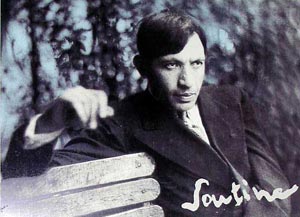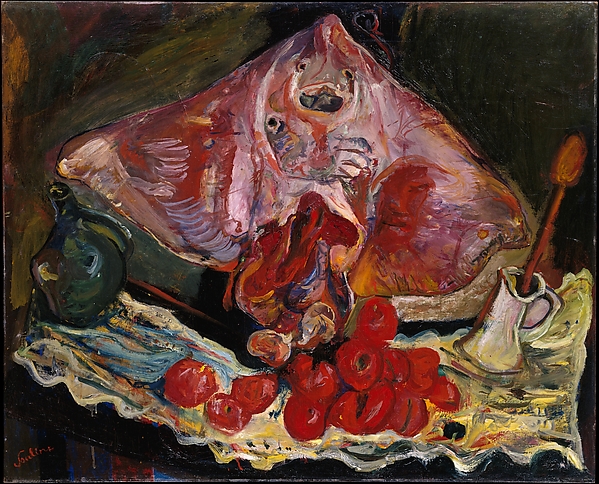Art Review: In the Flesh, Chaim Soutine at the Jewish Museum in New York City. “The Transitivity between Humans and Animals”

The Jewish Museum in New York City is currently presenting the work of Chaim Soutine (1893-1943), featuring just over thirty paintings by one of the most distinctive and significant artists of the early twentieth century. Focusing on still life paintings, of which he was a master, “Chaim Soutine: Flesh” includes his vigorous depictions of various slaughtered animals – of beef carcasses, hanging fowl, and game. These are dynamic works of great boldness and intensity, and taken together they constitute a sustained and profoundly sensuous interrogation of the flesh, of carnality – of blood, skin and sinew.
Soutine was a Russian-French Jew, born in Smilavichy (in present day Belarus), the tenth child of an extremely religious tailor who wanted his son to become a shoemaker. Routinely beaten, Soutine grew up in poverty amidst virulent anti-Semitism. By 1913, he arrived in Paris where he would train at the École des Beaux-Arts under Fernand Cormon, chiefly known for his images of the macabre. It was not long before Soutine established his individual style and technique, which dispensed with preliminary drawing, and was marked by a striking use of color and an enlivened, animated brush. In 1923, a collector purchased almost all of his work: Soutine went from being a literally starving artist to a celebrity almost overnight.
Still Life with Rayfish (1924) (Source: The Met)
The exhibition commences with Still Life with Rayfish (1924) – on loan from the Metropolitan Museum of Art – a painting which is characteristically Soutine: at once rather unsettling and at the same time utterly transfixing. The motif of the rayfish can be traced back to Jean-Baptiste-Siméon Chardin‘s masterpiece, The Ray (1728). Soutine is often engaged with the old masters, whose works he discovered at the Louvre – but rather than copying or working directly from their paintings he would stage their subjects for himself within his studio, revealing an acute sensitivity towards the real fleshly being before him. The ray’s mouth is agape and seems to be locked in a silent yet ceaseless cry. The painting is an excellent introduction to this artist, who was virtually obsessed with the fundamental mystery of embodiment, and the way humans and animals echo one another.
Not only dead creatures, but also even inanimate objects are quickened and enlivened by the touch of Soutine’s brush. Forks, for example, are subtly anthropomorphized: they become grasping hands, emaciated arms. Soutine himself was no stranger to hunger and he suffered from a severe gastro-intestinal condition that precluded him from eating the very meats he painted with such diligence.
The Fish (1933) (Source: The Athenaeum)
The Fish (1933) is looking back to Gustave Courbet‘s Trout (1872) even as it breaks away with its expressionistic use of impasto (thick globs of paint) – an approach to texture that is startling in its boldness and beauty. Soutine does not simply depict the surface of the creature: we see the skin as skin — as an organ that is lived and living, that suffers and is suffered. Soutine’s quivering fish reminds us that the epidermis of the skin is “like a pond surface or forest soil; not a shell so much as a delicate inter-penetration.”
A number of the artist’s living animals are included in the show. They are haunting paintings, which invariably convey a sense of entrapment and fear, a vulnerability that does not merely accompany, but constitutes, the reality of carnal existence. It is however for his slaughtered animals that Soutine is more truly remembered. And perhaps this was inevitable – as Soutine recalled:
“Once I saw the village butcher slice the neck of a bird and drain the blood out of it. I wanted to cry out, but his joyful expression caught the sound in my throat. This cry, I always feel it there. When, as a child, I drew a crude portrait of my professor, I tried to rid myself of this cry, but in vain. When I painted the beef carcass it was still this cry that I wanted to liberate. I have still not succeeded.”
The carcasses of beef – of which Soutine painted at least ten – are among his most significant achievements. While he takes his initial inspiration from Rembrandt’s Flayed Ox (1655), which he would have encountered at the Louvre, Soutine does not simply copy the work of his predecessor. In fact, he famously hung actual beef carcasses from the rafters of his Monparnasse studio. Like Rembrandt’s Flayed Ox, Soutine’s beef carcass resembles the crucifixion of Christ. But Soutine would surpass even Rembrandt in his prolonged interrogation of the flesh as a kind of elemental being. Soutine would repeatedly pour blood onto the carcass to re-enliven the decomposing flesh and enhance its color. The powerful stench of rotting meat, as well as the leaking of blood through the studio floor led neighbors to complain (and in fact to suspect that someone had been murdered) – so much so that the police came to confiscate the putrefying carcass. The authorities were instead treated to a lengthy discussion on the high demands of Art.
Perhaps what is most startling is that both blood and mud seem to have been applied to the canvas itself, calling forth an extremely visceral experience. These are extraordinarily powerful works of art that seem indeed to cry out to us in a primordial language: the splayed carcass suggests a kind of martyrdom; a melancholic, even tragic, vision of the world; a profound awareness of the inexorable processes of death, putrefaction and decay.
The art historian Sam Hunter observed that for painters such as Chaim Soutine and Francis Bacon (who undoubtedly encountered Soutine’s work),
“Flesh is … the essential material of being and of things, life’s basic substance.”
Soutine reminds us that painters of the highest order perform a kind of ontological function, an operation on behalf of being itself – a function that involves the turning back of the flesh of the world on itself. If Soutine’s work beckons us toward a compassion for animals, it is not by appealing to any rational moral principle; nor does it derive its authority from an extra-worldly source. Its origin is literally in the flesh, in the intercorporeity, the transitivity that exists between humans and animals – a connection and separation that is the presupposition and ground of carnal empathy.
*
Sam Ben-Meir is a professor of philosophy and world religions at Mercy College in New York City.


